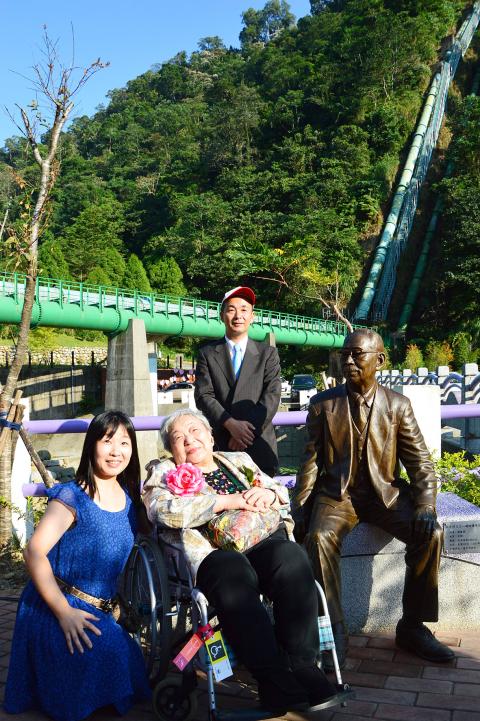Greater Taichung residents last week unveiled a statue dedicated to Japanese engineer Norio Isoda, in memory of his work in the construction of Baileng Canal (白冷圳), built to irrigate farms and supply municipal water early in the 20th century.
The commemoration took place on Tuesday last week at the site of the canal in Sinshe District (新社) and was attended by Isoda’s daughter, Yoshiko Matsutoya, 85, as well as other family members, who traveled from Japan to attend the commemoration.
Construction began in 1928, and the canal was completed in 1932. It provided irrigation for tens of thousands of farmers and the supply of water for residents and industry, helping develop what were then the rural townships of Sinshe, Dongshih (東勢) and Shihgang (石岡).

Photo: Chang Jui-chen, Taipei Times
Honoring the canal’s designer and head engineer, residents recognized Isoda as “Father of Baileng Canal.”
“The bronze statue is very much like my father. Now he can remain here always, observing each day’s sunrise and sunset, the seasonal movements of the moon and stars, as he watches over and protects the Baileng Canal for all time,” Matsutoya said.
Commissioned by the Greater Taichung Government’s Water Resources Bureau, the status was made by famed artist Hsieh Tung-liang (謝棟樑).
The statue was built to life-size scale and has Isoda wearing his favorite Western-style suit, seated on a stone bench.
Behind the statue is the 320m-long Baileng Canal No. 2 pipe, which rises up over a mountain.
This section of the canal was Isoda’s best-known engineering work, and is still the longest hydrological conduit in East Asia, designed on the “inverted siphon” operating principle.
The entire canal project was designed and built by Isoda to draw water from the Dajia River (大甲溪) for use in the surrounding farmlands, villages and towns. It is 16.6km in length and irrigates 788 hectares of farmland.
Matsutoya was born in Taipei during the Japanese colonial period.
As a child, she followed her father on his inspection rounds around Sinshe and rural Taichung.
“I remember my father took me around here to inspect the Baileng Canal. He and I would stroll along the river banks and the levee dikes,” she said.
“My longest-lasting impression of my father was when a typhoon was coming, he would go out to inspect the project while wearing a farmer’s bamboo leaf hat. Even with the heavy winds and rain coming down hard, he went out to check on the engineering work because he wanted to ensure the progress on the construction was not delayed,” she said.
Matsutoya grew up in and was educated in Taiwan, but left for Japan when she was 20, when Japanese rule in Taiwan ended at the end of World War II.
Matsutoya said she was moved to tears when farmers from Sinshe District visited her home in Japan last month, bringing gifts of mushrooms.
Besides Matsutoya, a 31-member Japanese delegation also attended the commemoration, including other family members, officials from Kanazawa City where Isoda’s family came from, and representatives from organizations promoting Taiwan-Japan friendship exchanges.
Ninty-seven-year-old farmer Yang A-han (楊阿漢) gave his perspective, saying: “Agricultural produce in Sinshe depended on irrigation from the Baileng Canal. Because of the project, the standard of living of local residents improved. The canal also enabled Sinshe to develop our current mushroom and orchid flower industries.”
“I have tremendous respect for the head engineer. The respect for Isoda is endlessly flowing forth like a well spring,” Yang added, even though he never met Isoda in person.

An essay competition jointly organized by a local writing society and a publisher affiliated with the Chinese Communist Party (CCP) might have contravened the Act Governing Relations Between the People of the Taiwan Area and the Mainland Area (臺灣地區與大陸地區人民關係條例), the Mainland Affairs Council (MAC) said on Thursday. “In this case, the partner organization is clearly an agency under the CCP’s Fujian Provincial Committee,” MAC Deputy Minister and spokesperson Liang Wen-chieh (梁文傑) said at a news briefing in Taipei. “It also involves bringing Taiwanese students to China with all-expenses-paid arrangements to attend award ceremonies and camps,” Liang said. Those two “characteristics” are typically sufficient

A magnitude 5.9 earthquake that struck about 33km off the coast of Hualien City was the "main shock" in a series of quakes in the area, with aftershocks expected over the next three days, the Central Weather Administration (CWA) said yesterday. Prior to the magnitude 5.9 quake shaking most of Taiwan at 6:53pm yesterday, six other earthquakes stronger than a magnitude of 4, starting with a magnitude 5.5 quake at 6:09pm, occurred in the area. CWA Seismological Center Director Wu Chien-fu (吳健富) confirmed that the quakes were all part of the same series and that the magnitude 5.5 temblor was

The brilliant blue waters, thick foliage and bucolic atmosphere on this seemingly idyllic archipelago deep in the Pacific Ocean belie the key role it now plays in a titanic geopolitical struggle. Palau is again on the front line as China, and the US and its allies prepare their forces in an intensifying contest for control over the Asia-Pacific region. The democratic nation of just 17,000 people hosts US-controlled airstrips and soon-to-be-completed radar installations that the US military describes as “critical” to monitoring vast swathes of water and airspace. It is also a key piece of the second island chain, a string of

The Central Weather Administration has issued a heat alert for southeastern Taiwan, warning of temperatures as high as 36°C today, while alerting some coastal areas of strong winds later in the day. Kaohsiung’s Neimen District (內門) and Pingtung County’s Neipu Township (內埔) are under an orange heat alert, which warns of temperatures as high as 36°C for three consecutive days, the CWA said, citing southwest winds. The heat would also extend to Tainan’s Nansi (楠西) and Yujing (玉井) districts, as well as Pingtung’s Gaoshu (高樹), Yanpu (鹽埔) and Majia (瑪家) townships, it said, forecasting highs of up to 36°C in those areas